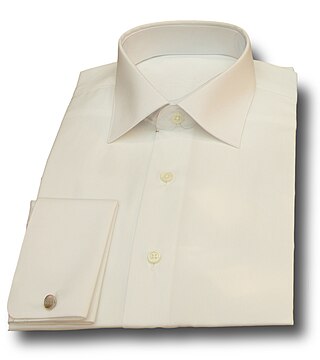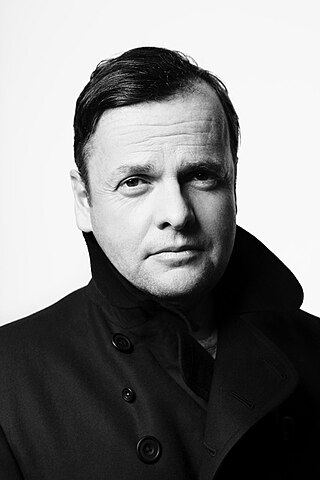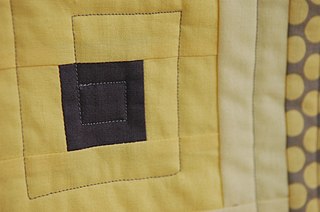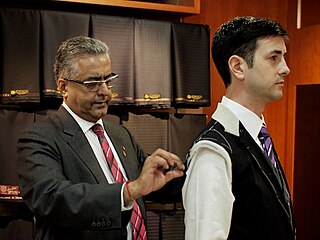Related Research Articles

Sewing is the craft of fastening or attaching objects using stitches made with a sewing needle and thread. Sewing is one of the oldest of the textile arts, arising in the Paleolithic era. Before the invention of spinning yarn or weaving fabric, archaeologists believe Stone Age people across Europe and Asia sewed fur and leather clothing using bone, antler or ivory sewing-needles and "thread" made of various animal body parts including sinew, catgut, and veins.

Ready-to-wear (RTW) – also called prêt-à-porter, or off-the-rack or off-the-peg in casual use – is the term for garments sold in finished condition in standardized sizes, as distinct from made-to-measure or bespoke clothing tailored to a particular person's frame. In other words, it is a piece of clothing that was mass produced in different sizes and sold that way instead of it being designed and sewn for one person. The term off-the-peg is sometimes used for items other than clothing, such as handbags.

A suit, lounge suit, or business suit is a set of clothes comprising a suit jacket and trousers of identical textiles generally worn with a collared dress shirt, necktie, and dress shoes. A skirt suit is similar, but with a matching skirt instead of trousers. It is currently considered semi-formal wear or business wear in contemporary Western dress codes, however when the suit was originally developed it was considered an informal or more casual option compared to the prevailing clothing standards of aristocrats and businessmen. The lounge suit originated in 19th-century Britain as sportswear and British country clothing, which is why it was seen as more casual than citywear at that time, with the roots of the suit coming from early modern Western Europe formal court or military clothes. After replacing the black frock coat in the early 20th century as regular daywear, a sober one-coloured suit became known as a lounge suit.

A tailor is a person who makes or alters clothing, particularly in men's clothing. The Oxford English Dictionary dates the term to the thirteenth century.

A dressmaker, also known as a seamstress, is a person who makes clothing for women, such as dresses, blouses, and evening gowns. Dressmakers were historically known as mantua-makers, and are also known as a modiste or fabrician.

In sewing and fashion design, a pattern is the template from which the parts of a garment are traced onto woven or knitted fabrics before being cut out and assembled. Patterns are usually made of paper, and are sometimes made of sturdier materials like paperboard or cardboard if they need to be more robust to withstand repeated use. The process of making or cutting patterns is sometimes compounded to the one-word Patternmaking, but it can also be written pattern(-)making or pattern cutting.

A dress shirt, button shirt, button-front, button-front shirt, or button-up shirt is a garment with a collar and a full-length opening at the front, which is fastened using buttons or shirt studs. A button-down or button-down shirt is a dress shirt with a button-down collar – a collar having the ends fastened to the shirt with buttons.

Bespoke tailoring or custom tailoring is clothing made to an individual buyer's specifications by a tailor.

A cuff is a layer of fabric at the lower edge of the sleeve of a garment at the wrist, or at the ankle end of a trouser leg. The function of turned-back cuffs is to protect the cloth of the garment from fraying, and, when frayed, to allow the cuffs to be readily repaired or replaced, without changing the garment. Cuffs are made by turning back (folding) the material, or a separate band of material can be sewn on, or worn separately, attached either by buttons or studs. A cuff may display an ornamental border or have lace or some other trimming. In US usage, the word trouser cuffs refers to the folded, finished bottoms of the legs of a pair of trousers. In the UK, while this usage is now sometimes followed, the traditional term for the turned up trouser hem is 'turnup'.

In sewing, to tack or baste is to sew quick, temporary stitches that will later be removed. Tacking is used for a variety of reasons, such as holding a seam in place until it is sewn properly, or transferring pattern markings onto the garment. Tacking is typically sewn using a specialised tacking thread, which may snap easily in order for it to be easily removed from the garment when necessary.

Fashion design is the art of applying design, aesthetics, clothing construction and natural beauty to clothing and its accessories. It is influenced by culture and different trends, and has varied over time and place. "A fashion designer creates clothing, including dresses, suits, pants, and skirts, and accessories like shoes and handbags, for consumers. He or she can specialize in clothing, accessory, or jewelry design, or may work in more than one of these areas."

H. Huntsman & Sons is a high-end fashion house and tailor located at No. 11 Savile Row, London. It is known for its English bespoke menswear tailoring, cashmere ready-to-wear collections, and leather accessories.

Darts are folds sewn into fabric to take in ease and provide shape to a garment, especially for a woman's bust. They are used frequently in all sorts of clothing to tailor the garment to the wearer's shape, or to make an innovative shape in the garment. Fabric may be thought of as flat, and a dart has the effect of removing a wedge shaped piece and pulling the edges of that wedge together to create a shallow cone. This effect can be seen quite easily with a paper pattern by pulling together the edges of a dart intake as it would be sewn. Since fabric is generally more flexible than paper, the fabric will shift around the apex of the cone and form a softer, but still curved, shape. In a garment, a dart ends in a point at a full area of the body.
Sewing is the craft of fastening or attaching objects using stitches made with needle and thread. Sewing is one of the oldest of the textile arts, arising in the Paleolithic Era. Although usually associated with clothing and household linens, sewing is used in a variety of crafts and industries, including shoemaking, upholstery, sailmaking, bookbinding and the manufacturing of some kinds of sporting goods. Sewing is the fundamental process underlying a variety of textile arts and crafts, including embroidery, tapestry, quilting, appliqué and patchwork.

Timothy Charles Peto Everest is a Welsh tailor and fashion designer. He moved to London in his early twenties to work with the Savile Row tailor Tommy Nutter. He then became one of the leaders of the New Bespoke Movement, which brought designer attitudes to the traditional skills of Savile Row tailoring.

In sewing, a seam is the join where two or more layers of fabric, leather, or other materials are held together with stitches. Prior to the invention of the sewing machine, all sewing was done by hand. Seams in modern mass-produced household textiles, sporting goods, and ready-to-wear clothing are sewn by computerized machines, while home shoemaking, dressmaking, quilting, crafts, haute couture and tailoring may use a combination of hand and machine sewing.

In sewing and tailoring, a lining is an inner layer of fabric, fur, or other material inserted into clothing, hats, luggage, curtains, handbags and similar items.

The word bespoke has evolved from a verb meaning 'to speak for something', to its contemporary usage as an adjective. Originally, the adjective bespoke described tailor-made suits and shoes. Later, it described anything commissioned to a particular specification. In contemporary usage, bespoke has become a general marketing and branding concept implying exclusivity and limited runs.
Alton Lane is an American menswear company founded in 2009 by Colin Hunter and Peyton Jenkins, graduates of the University of Virginia. Alton Lane offers modern bespoke suits, blazers, trousers, tuxedos, and shirts. The company is headquartered in Richmond, Virginia, and its suits are produced in Germany, Italy, and Thailand. Alton lane uses a combination of 3D body scanners and hand measurements to produce fully custom clothing.

The Hong Kong tailors are a well-known attraction in Hong Kong. Hong Kong is still home to several bespoke tailors, who have stitched suits for foreign politicians like Bill Clinton, George W Bush, Margaret Thatcher, Tony Blair and Bob Hawke and celebrities like King Charles, Kevin Spacey, Boris Becker, David Bowie, Richard Gere and Michael Jackson.
References
- 1 2 "Made To Measure Vs. Custom What Is The Difference?". eriktampa.com. 26 October 2019. Retrieved 2023-01-28.
- ↑ Brooke, Simon (March 31, 2007). "Just how personal can you get". Financial Times. Retrieved 2008-10-09.
- ↑ "Sartoriani London". Archived from the original on 2008-11-22. Retrieved 2008-10-09.
- ↑ "bespoke". Michael Quinion. September 13, 2008. Retrieved 2008-10-09.
- ↑ Sim, Josh (2008-07-12). "The b-word: not cut and dried". Financial Times. Retrieved 2008-10-10.
- ↑ Crompton, Simon (2008-07-01). "A loss to (sartorial) language". Men's Flair. Archived from the original on 2008-10-21. Retrieved 2008-10-10.
- ↑ "3 Types of Shirts: MTM vs OTR vs Bespoke". gentlemansgazette.com. 8 February 2021. Retrieved 2023-01-28.
